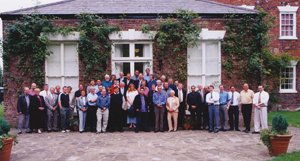articles/Training/newmanchester-page2
Dave Newman Draws Crowds to Chester - part 2 of 1 2 3
Published 01/10/2001

In considering Portraiture one should think constantly about ratios. Ratios are the relationships between the quantity or amount or size. In this respect photographers need to think about: Lighting, Zoom, Aspect, Density, Distance Depth of Field, Enlargement, Reduction, Power Lighting creates mood and feeling by the: Colour, Direction, Intensity, Ratio, Quality The use of reflectors and natural light all play their part. In portraiture there are the shadow and highlight sides of faces.
A typical lighting 'Recipe' may consist of: Separator Lights, Hair light, Background light, Accent light Ratio Lights, Key light, Fill light. The latter being used to give a non-specula, non-directional overall wash of even illumination. Ideally these last two lights should be set at a 4:1 ratio (see later).
Dave explained that he puts his lights on moveable tracks the sort used for garage door tracks. At this point Dave mentioned the benefit of using DIY stores and indeed car boot sales for all sorts of building materials/props for the camera room.
I bet that went down really well from the owner of Studio Decor, one of the trade stands present. Still, I think he took it in good heart and, in looking at some of the splendid goods on offer, one would have to traipse around many a car boot sale to find anything near the equivalent of what was on offer on the stand or in the catalogue. Start by adding the Background light and the Hair light. Then add the Key light. This obtains the complimentary ratio for optimum quality and gives for ease of printing. Remember that light is the photographer's paintbrush.
Portrait Lighting ratios:
No difference between Key and Fill 2:1
1 stop difference 3:1
11/2 stops difference 4:1
2 stops difference 5:1
3 stops difference 9:1 - this latter is best with a Rodenstock Imagon Diffuser Lens Diffusion cuts down the lighting ratio. In camera, highlights go into shadow, but in the darkroom shadows go into highlights, therefore it is best to do in camera diffusion.
Dave uses what he calls the ICCK method of exposure.
Independent reading of' Lights Common lights (reading of all the lights, except the key Key Light 1½ stops above common lights. In what seems to us a very large studio, Dave uses a broad hair light for large groups. He then went on to give various tips for props, attracting attention especially for children, filters, coping with failing eyesight and using a camera stand not a tripod.
In Classic Portraiture, one should be aware of physiognomy (the study of' the face) and the No. I thing one should do for our clients is to flatter them. Faces come in different shapes, but we should be able to cope with all sorts. By correctly posing our clients, imperfections should be minimised and we also have a number of' choices within the studio to control these. Dave went into great detail regarding lighting e.g. broad and short lighting, lighting styles to reveal how he copes with our client's imperfections. He then explained the Classic Views one could take of our subjects, remembering the old adage "one for show and one for dough".
Dave then went on to explain some methods of building up 'store "loyals" with the use of miniprints for both weddings and portraits.
We retired to the dining room for an excellent lunch. The break also gave us the opportunity of visiting the trade stands but before the start of the first afternoon session with Jim Chamberlain, it was outside for everyone for the customary "team photograph". This proved interesting as everybody suddenly descended on me with their cameras to take their record shots as well. Much amusement was had by those who saw me struggling with one of those queer little digital cameras especially when I looked through the viewfinder the wrong way round and nearly took a superb picture of my right ear!
In Dave 's final session, he dealt with posing and composing. He started this by quoting Edward de Croce who said that visual truth which separates amateurs from artists. Dave explained what differences there should be for both feminine posing and masculine posing, camera heights for full length, head & shoulders, placement within the composition, leg/foot/arm/hand posing e.g. making sure the metacarpal phalangeal joints are smoothed out (see Dave - I did write it down and spelt it correctly), and seated/standing posing. A final mention of various DIY props concluded Dave's seminar to rapturous applause.
Jim Chamberlain took up the first session of the afternoon. He is one of a very few photographers who actually test Epson printers e.g. the new 10,000 range (these can produce prints 44" wide!). He explained to much nodding from those in the know, that Photoshop takes time to learn. He only uses pigmented inks, which are claimed to give 150 years archival quality as opposed to waterbased inks, which don't last as long.
Please Note:
There is more than one page for this Article.
You are currently on page 2
- Dave Newman Draws Crowds to Chester page 1
- Dave Newman Draws Crowds to Chester page 2
- Dave Newman Draws Crowds to Chester page 3
1st Published 01/10/2001
last update 09/12/2022 14:56:56
More Training Articles
There are 0 days to get ready for The Society of Photographers Convention and Trade Show at The Novotel London West, Hammersmith ...
which starts on Wednesday 15th January 2025





